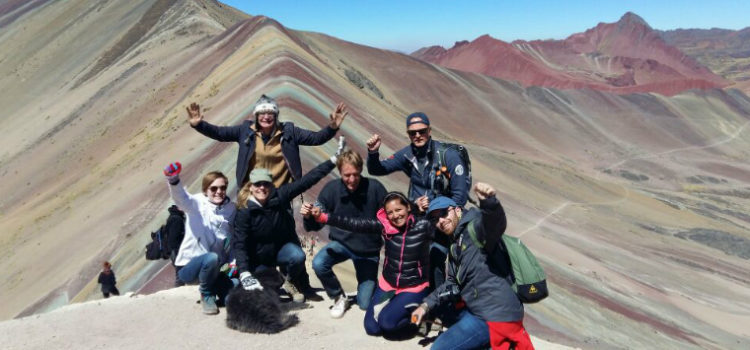Rainbow Mountain
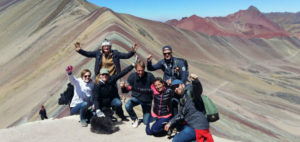 The Rainbow Mountain otherwise known as Motaña de Siete Colores (Mountain of Seven Colors) or Vinicunca (original Quechua name of the location – kunka means ‘neck’ in English) is stunning. The sedimentation of different minerals and the geological forces that lifted the peaks to 5,100m (16,732 ft.) resulted in a truly spectacular view that visitors from near and far come to experience. No need to be an expert outdoor person, however the hike to the top is challenging, so this trip requires good acclimatization – at least full 48 hours in Cusco altitude – and some preparation.
The Rainbow Mountain otherwise known as Motaña de Siete Colores (Mountain of Seven Colors) or Vinicunca (original Quechua name of the location – kunka means ‘neck’ in English) is stunning. The sedimentation of different minerals and the geological forces that lifted the peaks to 5,100m (16,732 ft.) resulted in a truly spectacular view that visitors from near and far come to experience. No need to be an expert outdoor person, however the hike to the top is challenging, so this trip requires good acclimatization – at least full 48 hours in Cusco altitude – and some preparation.
Ausangate Circuit Trek
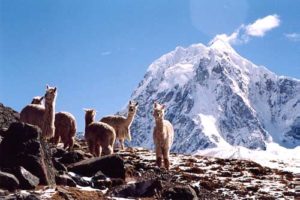 The Ausangate trekking circuit goes through some of the most beautiful landscapes of the Cusco region.[*] The five or six days of this itinerary goes around the Ausangate Mountain – Awsanqati in Quechua – along hot springs, and pristine turquoise blue and red lakes. The views of the glacier are amazing. The region is home to ‘one of the few remaining pastoralist societies in the world’ herding llamas and alpacas.[1] This high elevation is also the natural habitat of graceful vicuñas, the non-domesticated kind of the Andean Camelids. Most of the year the trail is covered with sparkling snow reflecting gleaming sun rays. No wonder that Ausagnate trek is the 4th best in the world according to besthike.com ranking.
The Ausangate trekking circuit goes through some of the most beautiful landscapes of the Cusco region.[*] The five or six days of this itinerary goes around the Ausangate Mountain – Awsanqati in Quechua – along hot springs, and pristine turquoise blue and red lakes. The views of the glacier are amazing. The region is home to ‘one of the few remaining pastoralist societies in the world’ herding llamas and alpacas.[1] This high elevation is also the natural habitat of graceful vicuñas, the non-domesticated kind of the Andean Camelids. Most of the year the trail is covered with sparkling snow reflecting gleaming sun rays. No wonder that Ausagnate trek is the 4th best in the world according to besthike.com ranking.
Discovering Lake Titicaca, Puno, Peru
 Titiqaqa – Quechua spelling – is known as ‘the highest navigable lake in the world, with surface elevation of 3,812 meters (12,507 ft).’ [1] The Titicacas’s name is interpreted as ‘puma’, due to the shape of the lake. Temperatures are influenced by the high altitude rather than the tropical latitude. The locals joke to have the cold season and the colder season; the cold season being the dry one and the colder season being the rainy one. The temperatures rarely get over 15°C during the day and the drop below the freezing point at night. Sun rays are very strong in this high Altiplano location, so 50+ sunblock is a must. A pair of comfortable water-proof shoes too.
Titiqaqa – Quechua spelling – is known as ‘the highest navigable lake in the world, with surface elevation of 3,812 meters (12,507 ft).’ [1] The Titicacas’s name is interpreted as ‘puma’, due to the shape of the lake. Temperatures are influenced by the high altitude rather than the tropical latitude. The locals joke to have the cold season and the colder season; the cold season being the dry one and the colder season being the rainy one. The temperatures rarely get over 15°C during the day and the drop below the freezing point at night. Sun rays are very strong in this high Altiplano location, so 50+ sunblock is a must. A pair of comfortable water-proof shoes too.
Everything You Always Wanted to Know about Quechua
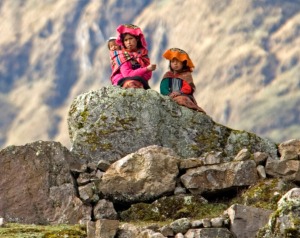 Most importantly Quechua speakers refer to their mother tongue as runasimi, which means ‘human speech’.[1] It is one of the 47 original languages spoken in Peru. Quechua is also spoken in Bolivia, Ecuador, Colombia, Argentina and Chile.[2] With the Inca conquest of more and more territory Quechua spread in a similar way Latin did in Europe with the Ancient Roman expansion. ‘Today there are approximately 24 dialects of Quechua […]. All of these varieties combined are spoken by approximately eight to 10 million people, making Quechua the most widely spoken indigenous language in the Americas.’ [3]
Most importantly Quechua speakers refer to their mother tongue as runasimi, which means ‘human speech’.[1] It is one of the 47 original languages spoken in Peru. Quechua is also spoken in Bolivia, Ecuador, Colombia, Argentina and Chile.[2] With the Inca conquest of more and more territory Quechua spread in a similar way Latin did in Europe with the Ancient Roman expansion. ‘Today there are approximately 24 dialects of Quechua […]. All of these varieties combined are spoken by approximately eight to 10 million people, making Quechua the most widely spoken indigenous language in the Americas.’ [3]
Here in Cusco Quechua is more than alive and kicking. You can hear it talking on the cell phone while going by bus. You can see it advertising Cusqueña the local beer from Cusco on TV. And also Oro (Gold) bubble-gum yellow soda in several witty TV commercials as if from the Inca times – don’t miss the twelve-angled pizza delivery one. Quechua studies at a university. It is taught in schools, language institutes and universities in Peru. Even foreigners living in here are learning this Andean language in workshops and courses organized by institutions like Dirección Regional de Educación de Cusco. What’s more Quechua is also taught at universities and language institutes outside of Cusco, outside of Peru and even outside of South America.
Lares – Alternative Route to Machu Picchu
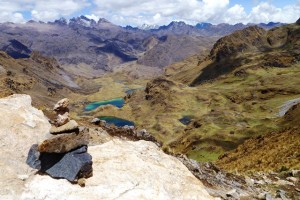 The remote Lares Valley is an excellent trekking place if you want to escape the crowds, clicking of cameras and experience genuine encounters with the local people.[1]
The remote Lares Valley is an excellent trekking place if you want to escape the crowds, clicking of cameras and experience genuine encounters with the local people.[1]
Remote Andean Villages
Breathtaking Landscapes
Hot Medicinal Springs
No Crowds or Overly-Traveled Trails
Personalized Service, Quality, Equipment, and Excellent Meals
‘Situated among the eastern slopes of the Andes and the northern sector of the Cordillera Urubamba, the Lares Valley is a wondrous place of brilliant glacial lakes and sub-tropical valleys filled with a rich assortment of vegetation and wildlife’ [2] with glaciers in the background. Small Quechua-speaking communities live in the Lares Valley continuing centuries old the farming, herding and weaving traditions of their ancestors.

